Indian Creek Wildflowers
Wildflower web sites of interest to aid in identifying wildflowers:
http://www.illinoiswildflowers.info
http://www.ct-botanical-society.org/galleries
http://www.missouriwildflowerguide.com
There are several different habitats in Indian Creek and different types of wildflowers will be found in each.
The Nature Area is very wooded and most areas are fully shaded, but it also has many trails which will receive some filtered sun or an hour or two of sun each day. It floods each spring, sometimes for several days.
The ditches along Eastwood Court and Candle Ridge road have more hours of sun but some parts still have partial shade, and of course, additional water when it rains. They are never cut.
The wooded yards along Bent Tree Lane have full shade, but are drier than the Nature Area, and do not flood in the spring. They are not generally cut.
The country roads around the Indian Creek subdivision are in full sun, and are cut only a few times a year, allowing wild flowers to grow between cuttings.
Note: the months noted below are the months that the plant can be found flowering.
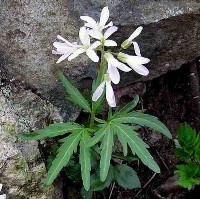
Woodland - native
Feb - May
found in wooded yard on Bent Tree Lane
Toothwort
Dentaria laciniata
Toothwort gets its name from its leaves, which have edges that look like ragged teeth. Toothwort blooms from February to May statewide in Illinois woodlands

Woodland - native
Early spring
found in wooded yard on Bent Tree Lane
White Trout Lily
Erythronium albidum
The white trout lily is commonly called the white dog-tooth violet.
Habitats include moist to mesic deciduous
woodlands and gentle slopes in wooded areas. An abundance of this plant
indicates that a woodlands has never been subjected to the plow or bulldozed
over. White Trout Lily is one of the spring wildflowers that is threatened
by the spread of Garlic Mustard in wooded areas. White Trout Lily
usually blooms a little earlier than other spring wildflowers in woodlands;
this blooming period is short, and immature plants that don't bloom always
outnumber mature plants.
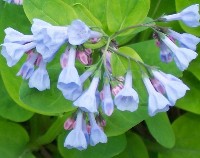
Woodland - native
March - May
found on forest floor in Nature Area
Virginia Bluebell
Mertensia virginica
Bluebells are named after the appearance of their flower. This plant blooms
from March through May in moist woodlands throughout Illinois,
especially in semi-shaded floodplain areas along rivers. Because of the attractive flowers
and foliage, it is cultivated occasionally in flower gardens. The
foliage dies down by mid-summer.
In Indian Creek in the springtime, bluebells form a carpet of blue
throughout the woods along the creek bed.

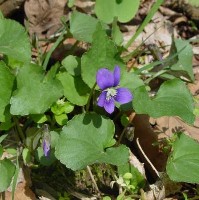
Woodland, Field, Roadside - native
March - May
found along trail in Nature Area
Blue Violet
Viola pratincola
This
native violet is the Illinois state flower. The leaves are nutritious and
can be used in salads and cooked as greens. The flowers may be used in
candies and jellies. The purple to blue flowers of the blue violet may be
seen blooming in every Illinois county from March to May in damp woods,
moist meadows, and roadsides.
Some species of ants harvest and "plant'' the ripe seeds, which contain a covering of attractive oils and possibly sugars. The ants carry the seeds, sometimes as far as 70 yards, to their nests where they consume the little treat. The shell, however, is too hard to open, so the ant discards the seed proper, often in an unused tunnel in the nest. Here, amid nutrients provided by the soil and accidentally by the housecleaning ants, the seed has a much better chance of producing a plant than does one dropped on the forest floor where it may be eaten by foraging birds and rodents.

Woodland - native
March - May
found in wooded yard on Bent Tree Lane
Spring Beauty
Claytonia virginica
This common plant, found throughout Illinois,
has small pink or white flower petals marked with pink veins. Spring
Beauties like light and close at night and in dark weather. Native
Americans, pioneers, and wildlife dug and ate the tubers and nibbled the
thick green leaves. Spring beauty blooms in woodlands, fields and older
residential areas from March through May.

Roadsides - introduced
March - Sept
found everywhere
Dandelion
Taraxacum
officinale
The common
Dandelion came to North America as a garden plant. The leaves may be eaten
fresh or cooked, and the roots can be cooked. A wine made from the heads
was once said to bring summer into the house during even the worst
blizzard. Now a mostly unloved weed, the Dandelion blooms from March to
Septembers in fields, roadsides, and lawns.
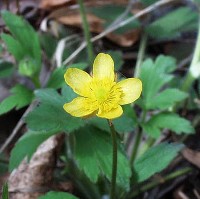
Woodland - native
March - May
found in wooded yard on Bent Tree Lane
Ranunculus fascicularis
This early buttercup is found in open and dry upland woods and roadsides.
The foliage of Ranunculus spp. (Buttercups) is more or less toxic and avoided by mammalian herbivores. However, their seeds are eaten to a limited extent by the Wild Turkey, Cottontail Rabbit, Fox Squirrel, Gray Squirrel, Eastern Chipmunk, and Meadow Vole. The Wild Turkey also browses on the foliage of Buttercups, notwithstanding its toxicity.
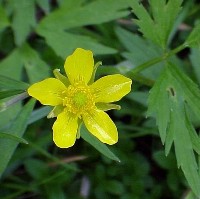
Woodland - native
April - May
found along trail in Nature Area
Swamp Buttercup
Ranunculus
septentrionalis
Swamp Buttercup is a
common plant that occurs in most counties of Illinois. Habitats include
moist to mesic deciduous woodlands, soggy areas along vernal pools, swamps,
partially shaded areas of seeps, and edges of woodland springs. The
preference is partial sun to light shade, slightly wet to mesic conditions,
and a fertile loamy soil with some leaf mould. Standing water from spring
rain is tolerated if it is temporary
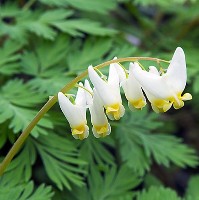
Woodland - native
April - May
found in wooded yard on Bent Tree Lane
Dutchman’s Breeches
Dicentra cucullaria
Dutchman's breeches has blossoms that resemble breeches or trousers. Dutchman's breeches grow statewide in Illinois in original woodland that has never been plowed under or bulldozed over. Because the seeds have elaisomes (fleshy or oily appendages), they are distributed by ants. Ants carry the seeds to their nests, eat the elaisomes, and discard the seeds some distance from the mother plant. Its white flowers appear in April and May.
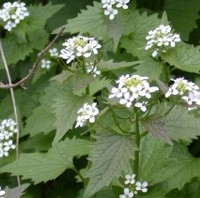
Introduced - Woodland
April - May
found on forest floor in Nature Area
Garlic Mustard
Alliaria
petiolata
Garlic Mustard is an invasive non-native (exotic) plant originally from
Europe, North Africa, and Asia. This biennial herb invades forested natural
areas dominating the ground layer and is a severe threat to native species.
The first season, it has low-growing clusters of leaves with jagged edges.
It stays green much of the winter. In the spring of its second year, it
sends up a slender, 12- to 30-inch stalk bearing small white flowers. The
plant dies at the end of the second summer, but its seeds remain viable for
up to six years. Dominant through their prolific seed production, dense
growth and by casting shade that weakens native plants, non-native invasive
plants should be destroyed when seen. Garlic mustard can be pulled by hand
or cut at soil level and treated with herbicide. It is best to kill this
biennial plant before it can cast its seeds.
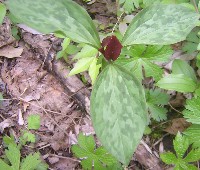
Woodland - native
April - June
found in wooded yard on Bent Tree Lane
Trillium
(Wake Robin)
Trillium recurvatum
The trillium is also
called Wake Robin because it blooms when the robins are returning to their
summer habitats. Various species have been used by Native Americans in many
ways: for food, to alleviate ailments, as an aphrodisiac, and to bring
ill-fortune to an enemy. It has three petals, three sepals and three leaves
and blooms in shady woodlands from April to June.
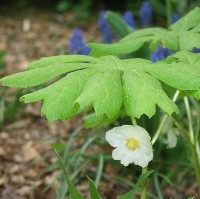
Woodland - native
April - June
found in wooded yard on Bent Tree Lane
Mayapple
Podophyllum peltatum
The Mayapple first appears as a green, pointed spear thrusting up out of the woodland floor. As it grows taller, the wide leaves unfurl. A colony of the plants can cover the ground when in full leaf. The large, white flower is hidden beneath the leaves. The ripe, golden yellow fruits of the Mayapple are edible when fully ripe and are sometime used to make interesting jelly, but the rest of the plant is poisonous. The root was once used for medicinal purposes, and the plant is sometimes called Mandrake because of the superstitiously feared, but also medicinally valued true Mandrake from the Old Word. Mayapple blooms from April to June
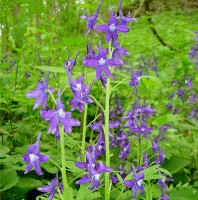
Woodland - native
April - June
found along roadside on Candle Ridge
Delphinium tricorne
Dwarf Larkspur occurs
occasionally in the southern half of Illinois, preferring woodlands and
rocky slopes. In Europe Larkspurs have been used for a variety of
medical uses including to help close wounds. The main use of the plant has
long been to kill human parasites, especially lice and their nits (eggs). It
was used by Wellington's troops at Waterloo and by Union soldiers during the
American Civil War. It is is
extremely poisonous to cattle.
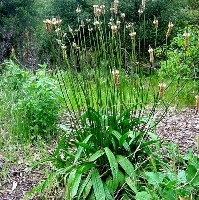
Roadsides - introduced
April - August
found along country road, one mile east of subdivision
Plantago lanceolata
English Plantain is a common plant that occurs
in every county of Illinois. It is native to Eurasia. Habitats include
lawns, cracks in pavement, vacant lots, fallow fields, and roadsides. It
prefers disturbed areas and has not invaded natural areas to any significant
extent.
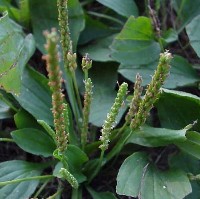
Roadsides - native
April - August
found along country road, one mile east of subdivision
Plantago rugelii
This is a very common plant that
occurs throughout Illinois. It can be found occasionally in open disturbed
areas of prairies, sometimes as an invader from more developed sites, such
as lawns. Other natural habitats include disturbed areas of meadows in
woodlands, woodland borders, and clay banks along streams. In more developed
areas, where this plant is ubiquitous, it can be found in lawns, gardens,
and vacant lots, or areas along roadsides, railroads, sidewalks, gravelly
driveways and alleys. This plant thrives on disturbance and cannot tolerate
much competition from taller plants with highly developed root systems.
This plant is widely regarded as an unattractive weed, but its ecological
value, particularly to small animals and moths, is rather high.
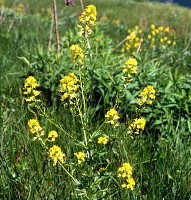
Roadsides and fields - introduced
April - August
found along roadside on Bent Tree Lane
Barbarea vulgaris arcuata
Yellow Rocket is a common plant that occurs in most counties of Illinois. It is native to Eurasia. Habitats include cropland, fallow fields, vacant lots, construction sites, gardens, moist meadows, areas along roadsides and railroads, and waste areas. The blooming period occurs from mid-spring to early summer and lasts about a month (peaking during late spring).

Lawns and gardens - introduced
April - July
found in the nature area and in lawns and gardens in Indian Creek
Glechoma hederacea
Ground ivy (Glechoma hederacea), also known as creeping Charlie and creeping Jenny, is a low-growing perennial weed that thrives in moist, shady areas of the lawn and garden, but will invade sunny areas, too, if the lawn is thin. The four-sided stems grow to lengths of 15-30 inches with roots forming at the nodes, where leaves join the stem. Its leaves resemble those of the common geranium, round and scalloped, but are much smaller in size. In the early spring an abundance of tiny, lavender to blue flowers appear on 2 or 3-inch spikes.
Ground Ivy is an important source of nectar during the spring for bees. Otherwise, its ecological value is rather low. The blooming period usually occurs from mid-spring to early summer for about 2 months, although some plants may bloom later in the year if they remain in cool shade or a major disturbance prevents earlier bloom.
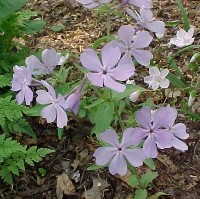
Woodland - native
May - June
found near the bridge on Eastwood Court
Woodland Phlox
Phlox divaricatus
Woodland phlox is a spreading, native wildflower which forms mats of foliage
with stems typically reaching 12-15" tall. As the common name suggests, this
is a woodland species which occurs in rich woods, fields and along streams
in the southern three-fourths of Illinois. Its sweet smelling light purple
flowers appear from May through June.

Woodland - native
May - June
found along trail in Nature Area
Hydrophyllum Virginianum
Virginia Waterleaf occurs occasionally in
central and northern Illinois blooms from mid-May to early June. Habitats include mesic deciduous woodlands,
areas along woodland paths, wooded slopes along rivers, and edges of
clearings in wooded areas. Its leaves are sometimes used as edible greens in
southeastern United States.
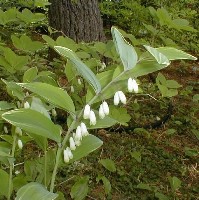
Woodland - native
May - June
found in wooded yard on Bent Tree Lane
Solomon's Seal
Polygonatum commutatum
Solomon's Seal appears throughout Illinois in woodland and fencerows that are overgrown with shrubs or trees, in light shade to partial sun. The blooming period occurs during late spring or early summer and lasts about 3 weeks. Each flower is replaced by a spheroid berry that is about 1/3–1/2" across. This berry is initially green, but it eventually becomes dark blue-violet. White-Tailed Deer are quite fond of the foliage and will chomp off the tops of plants to about 6" above the ground. The origin of the name may be because the root of the plant bears marks that resemble the stamp of a seal and called Solomon's because his seal occurred in oriental tales.
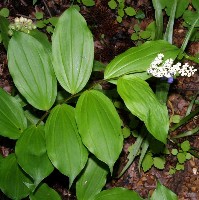
Woodland - native
May - June
found in wooded yard on Bent Tree Lane
False Solomon's Seal
Smilacina racemosa
A spike of white or yellow flowers appears on the tip of the strong, unbranched stem of the false Solomon's seal. The plant produces red berries which are enjoyed by grouse and other birds. These berries are edible, but rather bitter. It appears in moist woody areas and blooms from May to June. The plant is called false since it has none of the magical or medicinal properties of the eastern Solomon Seal.
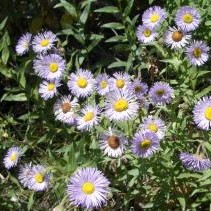
Woodland openings - native
May - July
found along trail in Nature Area
Erigeron philadelphicus
Habitats include moist black soil prairies, savannas and openings in woodlands, moist meadows near rivers, borders of lakes and edges of marshes, rocky bluffs, roadside ditches and low-lying areas along railroads, abandoned fields, vacant lots, and other waste areas. Moist disturbed areas are preferred. "Fleabane" is from an old English name, and refers to the plant's supposed ability to kill or drive away fleas. The Cherokee used an infusion of the roots to treat colds, coughs, and headaches. The Blackfeet used Philadelphia fleabane to treat diarrhea. The Mesquakies took snuff made of powdered disk flowers to alleviate head colds by causing sneezing.
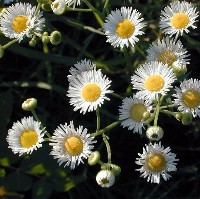
Roadsides - native
May - September
found in ditch on NW side of Eastwood Court
Erigeron annuus
Fleabanes get their common name from an old belief that they repelled fleas and other pestiferous insects. Early European settlers in North America stuffed mattresses with fleabane and hung clusters of plants in their cabins to drive out fleas. The custom persisted for generations, even though Daisy Fleabane appears to have no insect-repelling ability whatsoever. In fact, the plant ATTRACTS insects--not only pollinators but also tiny herbivores that nibble away the ray flowers and leave only the central disk.
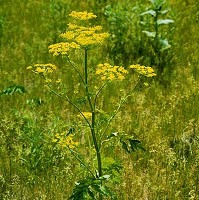
Roadsides - introduced
May - August
Pastinaca sativa
Wild Parsnip is a common plant that occurs in every county of Illinois.
Habitats include moist to mesic black soil prairies, savannas, pastures and
fields, weedy meadows, areas along railroads and roadsides, vacant lots, and
waste areas. Wild Parsnip can invade natural areas, especially prairies and
savannas with fertile soil. It is native to Europe. The flower stalks grow
about 4’ and have umbrella-like clusters of yellow flowers that form large
flat seeds.
CAUTION! If plant juices come in contact with the skin in the presence of
sunlight, a painful burn or blistering can occur resulting in a skin
discoloration for several months. This is the result of the foliage
releasing singleton oxygen, which is chemically highly reactive (to an even
greater extent than triplet oxygen, or ozone). Thus, the foliage in this
condition can irritate the digestive tracts of herbivores and raise blisters
on the skin of humans.
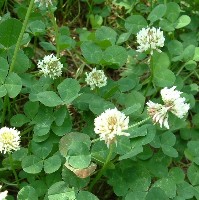
Roadsides - introduced
May - September
found in ditch on NW side of Eastwood Court
Trifolium repens
White Clover is one of the most
successful introduced species, having spread from Europe to most temperate
and subtropical zones around the globe. Fortunately it is of exceeding
usefulness and has been a boon for agricultural societies. White
Clover is found in meadows, pastures and along roadsides. It is
intentionally planted along with grasses to enrich pastures for cattle,
horses, sheep, or goats. It is also cultivated in poor soil during crop
rotations, as clovers help set nitrogen, and a season of clover dominance
will improve commercial crops in years to follow.
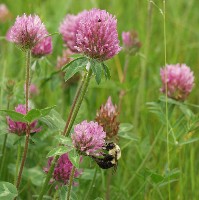
Roadsides - introduced
May - September
found in ditch on NW side of Eastwood Court
Trifolium pratense
Red Clover is a wide-spread
non-native plant, found from city lots to farm fields to mountain meadows.
It is a significant forage crop and a favorite with bees. It grows quickly
if given ample moisture and it is quite noticeable because of its large,
long-lasting, and colorful flower head and its large leaves. It is a
most desirable clover for beekeepers and clover honey is among the best of
honeys.
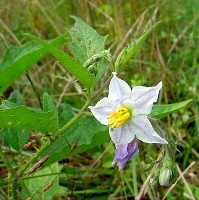
Roadsides - native
May - October
found in ditch on NW side of Eastwood Court
Solanum carolinense
Horse Nettle is widely regarded as a weed, with some justication, but it is also one of the native wildflowers of the prairie. The fruits are benefical to wildlife. Because of the intense competition among plants and their root systems, this plant is less aggressive in prairie habitats than in disturbed sites around developed areas.
This plant is extremely
poisonous to humans and livestock. The berries, when properly prepared, have
been used as diuretics, antispasmodics, anodynes; and according to the U.S.
Dispensatory, they have also been used in a treatment for epilepsy.
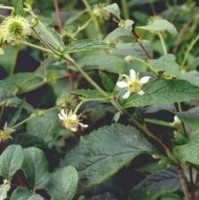
Woodland - native
May - October
found in wooded yard on Bent Tree Lane
Geum canadense
White Avens prefers light shade
or partial sun, moist to slightly dry conditions, and a loam or clay-loam
soil. At favorable sites, it can spread aggressively and is somewhat weedy.
Habitats include mesic deciduous woodlands, woodland borders, thickets,
partially shaded seeps, fence rows with woody vegetation, powerline
clearances in wooded areas, and edges of yards. Sometimes White Avens can be
found in disturbed meadows and tall-grass prairies, but this is atypical. It
adapts well to disturbed areas. The hooked achenes can cling to the
fur of mammals, feathers of birds, and clothing of humans; by this means,
they are distributed far and wide.
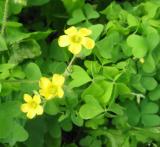
Woodland openings - native
May - October
found in wooded yard on Bent Tree Lane
Oxalis stricta
The Yellow Wood Sorrel grows 6 to 12 inches. Its blooming period peaks during late spring or early summer, but continues intermittently until the fall. Wood sorrel folds its leaves up at night and opens them again in the morning. It also folds its leaves when under stress, such as when growing in direct sun, or during storms. Wood sorrel prefers moist soil, and partial shade, but will grow in sun or shade, good soil or poor and is also commonly found growing through the cracks in sidewalks. It can withstand being walked on, mowed to within a quarter inch, and poisoned.
The leaves can be added to salads in small amounts – they have a slightly sour taste. A chilled, sweetened, wood sorrel tea makes a refreshing beverage along the lines of lemonade. Wood sorrel is quite high in ascorbic acid (vitamin C) and may provide other nutrients. Wood sorrel also contains rather high amounts of potassium oxalate and oxalic acid and should therefore be used in moderation, and avoided by people with kidney disease, kidney stones, rheumatoid arthritis, or gout.
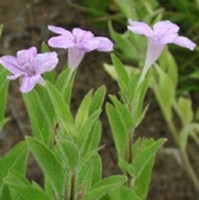
Roadsides - native
May - October
found along country road, one mile southeast of subdivision
Ruellia humilis
Hairy Wild Petunia occurs in
mesic to dry black soil prairies, gravelly hill prairies, dry open
woodlands, limestone glades, bluffs, sandy cemeteries, sand flats, and areas
along roadsides and railroads. This plant is typically found in areas with
poor soil and sparse vegetative cover, where it occurs sporadically in short
grass, rather than forming dense colonies. A flower typically opens
during the morning and falls off the plant by evening. The overall
appearance of Hairy Wild Petunia resembles cultivated petunias, but they are
members of different plant families. The blooming period occurs from early
summer to late summer, and lasts about 2 months.

Roadsides - introduced
June - July
found along country road, north of subdivision
Hemerocallis fulva
The Orange Day Lily has been observed in the wild in most counties of Illinois. It is probably more widespread than official records indicate, and is fairly common. Habitats include cemeteries and cemetery prairies, thickets and woodland borders, areas along railroads and roadsides, sites of abandoned homesteads, and old flower gardens. The Orange Day Lily usually occurs at disturbed sites, but it can also invade natural areas and become in time a nuisance. The Day Lilies originate primarily from East Asia
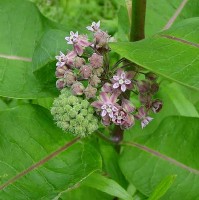
Roadsides - native
June - August
found in ditch at entrance to soccer field
Asclepias syriaca
Common Milkweed occurs in every
county of Illinois and is quite common. Habitats include moist to dry black
soil prairies, sand prairies, sand dunes along lake shores, thickets,
woodland borders, fields and pastures, abandoned fields, vacant lots, fence
rows, and areas along railroads and roadsides. This plant is a colonizer of
disturbed areas in both natural and developed habitats. The flowers
are very popular with many kinds of insects, especially long-tongued bees,
wasps, flies, skippers, and butterflies, which seek nectar. The
caterpillars of the Monarch Butterfly feed on the foliage, as well as
the caterpillars of a few moths, including Milkweed Tiger Moth, Unexpected
Cycnia, Delicate Cycnia.
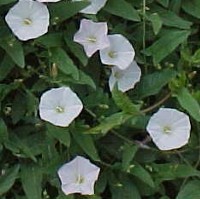
Roadsides - native
June - September
found in ditch on NW side of Eastwood Court
Convolvulus arvensis
The
blooming period can occur from late spring to early fall, and can span
several months, even though individual flowers persist for only a single
day, usually opening during the morning and closing by late afternoon. The
root system consists of a slender taproot that branches frequently; it can
extend 20' into the ground. Rhizomes are also produced in abundance, so that
this plant often forms vegetative colonies. It can be very aggressive
and persistent. Habitats include lawns, gardens, fields, clay banks,
areas along roadsides and railroads (including ballast), vacant lots, and
miscellaneous waste areas. This plant occurs primarily in disturbed areas.

Roadsides - introduced & native
June - September
Achillea millefolium
Yarrow is a common plant that has
naturalized in all counties of Illinois. It is also cultivated in flower and
herb gardens. Habitats include mesic to dry prairies, pastures, fallow
fields, grassy waste areas, and edges of paths, yards, or hedges. Disturbed
areas are preferred; Yarrow persists in native habitats to a limited extent.
Yarrow was introduced into the United States from Europe as an ornamental
and medicinal plant. However, a Western form of this species that is smaller
in size and woollier in appearance may be native to North America.
Yarrow's
highly honorable scientific name Achillea milefolium ("Achilles'
thousand-leaved herb") is named for the great Greek leader of warriors in
the Trojan War, who bound the wounds of his warriors with yarrow to
staunch the flow of their blood—ancient testimony to the herb's astringent
and antiseptic properties.
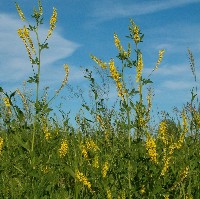
Roadsides - introduced
June - September
found in ditch on NW side of Eastwood Court
Melilotus officinalis
White and yellow sweet clover are very similar. Yellow sweet clover is usually shorter and blooms earlier. First year plants do not bloom. Second year plants grow 3 - 5' high and are bush-like. Sweet clovers are very fragrant.
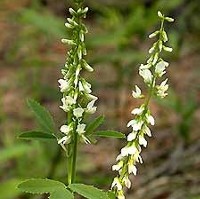
Roadsides - introduced
June - September
found in ditch on NW side of Eastwood Court
Melilotus alba
Sweet clover invades and degrades native grasslands by overtopping and shading native sun-loving plants thereby reducing diversity. It grows abundantly on disturbed lands, roadsides and abandoned fields. It responds favorable to prescribed burns by scarifying seeds thereby stimulating germination. First year plants are hard to detect. Native to Europe it was brought to the U.S. in the late 1600s and still used today as a forage crop and soil enhancer predominantly in the Great Plains and Upper Midwest.

Roadsides - introduced
June - October
found along soybean field 1 mile S of IC
Ipomoea hederacea
This introduced annual vine is up
to 6' long, branching occasionally. It was introduced from South
America as an ornamental plant, and it is probably still spreading
throughout Illinois. Habitats include fields, abandoned fields, areas
along roadsides and railroads, gardens, and miscellaneous waste areas. So
far this plant hasn't invaded native habitats to any significant degree, but
it is quite common in disturbed areas, especially cultivated fields, where
it can be a major pest.
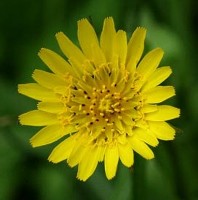
Roadsides - introduced
June - October
found in ditch on NW side of Eastwood Court
Tragopogon pratensis
This plant was introduced in America by the early colonists and spread rapidly, commonly growing in fields (hence its name) and on roadsides and flowering between June and October. Soon Indians were using it as a food source. The large fleshy taproots taste like parsnips when cooked. The roots, when roasted and ground, are considered by some as a coffee substitute.
Indians and settlers believed that the milky juice of the Salsify was useful in dissolving gallstones. They would also extract the milky juice, wait for it to curdle, and then chew it. This was used to keep the mouth moist and also to aid in digestion. An extract from simmering roots was used to relieve indigestion, heartburn, poor appetite, and liver trouble. Extracts were also used for sore eyes. Young roots washed, scraped, and cut up raw in salads were believed to be good for the stomach.
The flowers are open in the morning and close around noon.
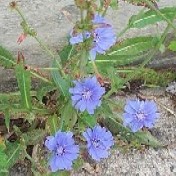
Roadsides - introduced
June - October
found in ditch on NW side of Eastwood Court
Cichorium intybus (Asteraceae)
A native of Europe, Chicory has escaped from cultivation and naturalized throughout North America. The plant contains a white, milky sap that appears if the stem is broken. Flowers are blue, remaining on the plant for only a single day. Prefers full sun in well-drained soils. Chicory can be found along roadsides in Indian Creek. When World War II disrupted shipping, most U.S. "coffee" was produced from chicory. Caffine-free, it is regaining popularity.
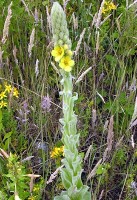
Roadsides - introduced
June - October
found along country road,
one mile east of subdivision
Verbascum thapsus
Great Mullein is a common plant that occurs in all counties of Illinois. It is native to Eurasia, and may have been introduced into the United States as an herbal or ornamental plant. Habitats include limestone glades, rocky slopes and clay banks, pastures and fallow fields, areas along railroads and roadsides, vacant lots, and dry waste areas. Disturbed areas are preferred. Great Mullein can grow to seven feet tall. The seeds can lie dormant in the soil for several decades and remain capable of germination.
Great Mullein has been used as an alternative medicine for centuries, and in many countries throughout the world, the value of Great Mullein as a proven medicinal herb is now backed by scientific evidence. Some valuable constituents contained in Mullein are Coumarin and Hesperidin; they exhibit many healing abilities. Research indicates some of the uses as analgesic, antihistaminic, antiinflammatory, anticancer, antioxidant, antiviral, bacteristat, cardiodepressant, estrogenic, fungicide, hypnotic, sedative and pesticide are valid
The leaves are huge, up to a foot long, and are very soft to the touch. They have been used as diapers and as wicks for lamps and candles. Infused with grease, the stalks have been used as torches.

Roadsides - introduced
June - October
found along country road, one mile east of subdivision
Rumex crispus
Each yellowish or reddish green
flower is about 1/8" long. The blooming period occurs during the summer and
lasts about a month. Each flower matures into a dry fruit about 1/6"
long that contains a single seed. The fruit and stems of Curly Dock
become dark brown with maturity. Curly Dock is a common plant that
probably occurs in every county of Illinois. It is native to Eurasia and was
first observed in the United States during the 18th century. Habitats
include seeps, glades, weedy meadows (including areas prone to occasional
flooding), pastures and fallow fields, vacant lots, roadside banks and
gravelly areas along railroads, edges of yards and gardens, and
miscellaneous waste areas. Disturbed areas are preferred.

Roadsides - native
July - August
found along country road,
one mile east of subdivision
Monarda fistulosa
Wild Bergamot is a member of the mint family. Its blooming period occurs during mid-summer and lasts about 1 month. Habitats include moist to slightly dry black soil prairies, hill prairies, sandy Black Oak woodlands, savannas and woodland borders, thickets, borders of limestone glades, abandoned pastures, and landfills. The rhizomes can survive earth-moving and bulldozing operations, and send up plants in unexpected places. For a member of the mint family, the flowers are large and beautiful.
Traditional and folk remedies and uses: used to increase mucus flow; treatment for colds, headaches, burns, and warts; kills bacteria, fungus growth and intestinal worms; high in vitamins A and C; leaves used in salads or dried for tea.

Woodland opening - native
July - August
found in opening in woods along Eastwood Court, southeast of soccer field
Vernonia missurica
Missouri Ironweed occurs throughout Illinois, except in the NW corner of the state. It is a common plant. Typical habitats include Wooded swamps, low meadows, waste places, overgrazed pastures and degraded prairies. This is an attractive plant when in bloom, and one of the best attractors of late summer butterflies.
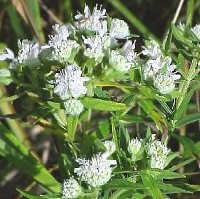
Woodland opening - native
July - August
found in opening in woods along Eastwood Court, southeast of soccer field
Pycnanthemum virginianum
Common Mountain Mint is widely distributed in northern and central Illinois. The name 'Mountain Mint' is something of a misnomer, because this plant and the majority of other members in this genus do not usually occur in mountainous habitats. There is a strong mint fragrance in the crushed leaves of Common Mountain Mint, and it is used as a seasoning in cooking.. Native Americans use the roots and leaves for medicine and for baiting mink traps.

Roadsides - introduced
July - September
found along soybean field 1 mile S of IC
Ipomoea purpurea
Beautiful and destructive, the tall morning-glory is an invasive wildflower vine that can grow 2.5 meters a day. Introduced from South America, Ipomoea purpurea is unopposed by the ranks of natural enemies that slow a native plant. Blooming from July to September, Ipomoea purpurea produces flowers that range in color from deep purple to white. Their mature fruit is a brown capsule containing 4 to 6 dark brown to black seeds. The decidedly heart-shaped leaves help distinguish it from most of the other morning glories. Parts of plant are poisonous if ingested. Hernando Cortes collected morning glory seeds from the Aztecs and took them back to Spain for the monastery gardens. The beauty of its flowers is Ipomoea purpurea's only apparent redeeming characteristic in North America.

Woodland - native
July - September
found on forest floor in Nature Area
Wood Nettle
Laportea canadensis
Wood nettle covers the floor of flood plain forests. It has stinging hairs on leaves that carry a toxic agent. The stinging hairs act like a hypodermic needle and consist of a fine capillary tube with a bladder like base that is filled with the chemical irritant. At the tip of the hair is a minute cap that breaks off on contact with the skin. The sharply pointed tip then penetrates the skin and injects the toxic fluid. The result is an intense burning and itching of the skin that persists for minutes to a few hours
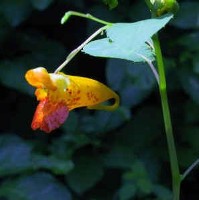
Shaded roadside ditch - native
July - September
found by culvert on south side of Candle Ridge Road, at south entrance of subdivision
Impatiens capensis
This native plant is a summer
annual that becomes 2-5' tall, branching occasionally. It grows
readily from seeds and often forms colonies by reseeding itself.
Jewelweed habitats include openings in moist woodlands, partially or lightly
shaded floodplains along rivers, edges of woodland paths, swamps, seeps and
fens, and roadside ditches.
Walking in the woods or working outdoors risks exposure to poison ivy,
poison oak, and stinging nettle. If exposed to these irritants, one should
immediately look for Jewelweed. The stem of the plant can be cut or mashed
and the juice rubbed on the exposed areas. The Jewelweed juice should
remove the Urushiol oil from the skin and prevent the onset of a rash.
Jewelweed juice can be used to help reduce inflammation and itching of a
rash caused by poison ivy and insect bites.
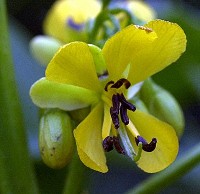
Woodland opening - native
July - September
found in opening in woods on Nature Trail
Senna hebecarpa
This native perennial plant is
largely unbranched and up to 6' tall. This species is occasional in
some areas, and uncommon or absent in others. Populations in the wild are
probably declining as a result of modern development. Habitats include moist
meadows near rivers, savannas, fens, pastures, and roadsides. It is often
flourishes within the floodplain of rivers.
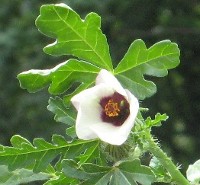
Roadsides - introduced
July - September
found along country road,
one mile east of subdivision
Photo by Helen Mogill
Hibiscus trionum
This flower is called flower-of-an-hour because of the short time each flower remains open. An old English name for the plant was "Good night at noone". It is found on disturbed sites, waste ground, and along roadsides and railroads, and can be a problem weed. Introduced from southern Europe, flower-of-an-hour is an annual plant that originally grew to the east of the Mediterranean, but spread throughout southern Europe both as a weed and cultivated as a garden plant. The plant grows to a height of 1 to 2 feet.
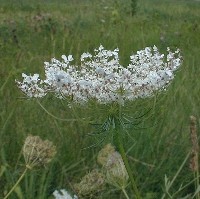
Roadsides - introduced
July - October
found in ditch on NW side of Eastwood Court
Daucus carota
Wild Carrot (or Queen Anne's
Lace) was introduced from Europe as a medicinal plant. The root system
consists of a stout taproot that is white and runs deep into the ground.
Wild Carrot is aggressive and can be difficult to destroy. It often survives
mowing and hand-pulling of plants by the rootstocks. This is because the
deep taproot is difficult to remove and stores considerable energy to
initiate new growth. Wild Carrot doesn't begin blooming until
mid-summer and usually occurs in mesic to dry areas, rather than wetlands.
The presence of a single reddish purple flower in the middle of the compound
umbel is a distinctive characteristic, although it is not always present.
Wild Carrot is an important source of the natural food dye, carotene, and
for this reason has commercial importance. According to most authorities, it
is the source of the cultivated carrot.
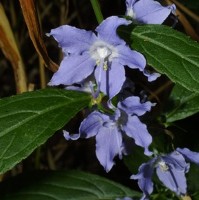
Woodland - native
July - October
found in woods in Nature Area
Campanulastrum americanum
This native plant is an annual or
biennial from 2-6' tall. Usually, it is unbranched, although sometimes a few
side stems will develop from the lower central stem. American
Bellflower is a common plant that occurs in most counties of Illinois.
Habitats include moist to slightly dry deciduous woodlands, woodland
borders, and thickets. It is often found along woodland paths, and appears
to prefer slightly disturbed areas.

Stream & woodland edges - native
August - October
found by bridge on Eastwood Court
Verbesina alternifolia
Wingstem grows up to 6 feet tall
in moist wooded slopes and open woodlands, riverbanks, shaded lowlands,
roadsides, fields in sun or partial shade. It usually doesn't wander far
from woodland areas or bodies of water. Wingstem is a favored treat of
bees and butterflies. The strongly winged central stem gives this
plant its common name.
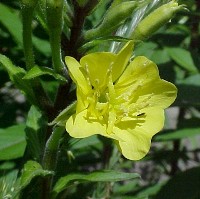
Roadsides - native
August - October
found in ditch on NW side of Eastwood Court
Oenothera biennis
The common evening primrose is a common biennial plant that is particularly conspicuous during late summer or fall. Disturbed areas are favored in both natural and developed habitats, including mesic to dry black soil prairies, sand prairies, thickets, glades, lakeshore dunes, abandoned fields, roadsides and railroads, slopes of drainage ditches, vacant lots, etc. Sometimes this plant is cultivated in wildflower gardens, from which it may escape. The first year there is only a rosette of basal leaves and a stalk with alternate leaves. The second year the plant flowers. The flowers open suddenly in the evening and, depending on the weather, usually fade in early to mid morning. The flowers attract sphinx moths. The dry stalks and seed pods persist and are sometimes use in dry arrangements. Native Americans rubbed the root on athletes to give them strength.
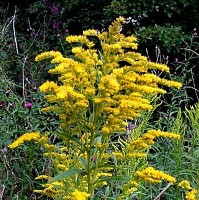
Roadsides - native
August - September
found in ditch on NW side of Eastwood Court
Solidago canadensis
Canada Goldenrod occurs in almost all of the counties in Illinois and is very common Natural habitats include disturbed areas of moist to dry prairies, openings in both floodplain and upland forests, thickets, savannas, limestone glades, and gravel seeps. In more developed areas, it occurs in both cultivated and abandoned fields, vacant lots, power-line clearance areas, and along fences, roadsides, and railroads. It presents no difficulties in growing, and some species threaten to be a nuisance. If goldenrod was not so plentiful, perhaps we would prize it more. Many species have been moved to the gardens of England and the European continent. Its dried leaves have been used for a tea-like beverage by the Indians. The scientific name, from the Latin, means "to make whole", and refers to the healing properties which have been attributed to it.
Goldenrod does not cause hay fever. It has been wrongly accused for the pollen problems created by ragweed and the grasses. Goldenrod has brightly colored flowers to attract color-sensitive insects. Its pollen grains are relatively large, heavier than air, because they are designed to be carried off by flies, bees, butterflies, even ants or birds, but not by the wind.
|
Home Burning Bylaws Covenants History Maps Newsletters Phones Septic Recycling Water Aerial Animals Birds Bluebells Fungi Gardens Invasives Pets Streets Trail Trees Wildflowers |
This page was last updated Saturday December 15, 2012.